In May, the bodies of 215 children—some as young as three years old—were discovered in an unmarked grave at a former Indian Residential School in Kamloops, B.C., after a search by the Tk’emlúps te Secwépemc First Nation. The grim discovery provided physical evidence to support what many from the Indigenous community have always known: thousands of children who went to residential schools never came home.
This painful reminder led to outpourings of grief and anger, along with calls to search the grounds at all former Indian residential schools. As memorials sprang up across the country, many mourners wore orange T-shirts or hung orange banners with the words “Every Child Matters.” Why the colour orange?
In 2013, Phyllis (Jack) Webstad shared the story of her first day at the St. Joseph Mission Residential School in Williams Lake, B.C., as part of a commemoration event for former students and their families. She was six years old, and her grandmother had bought her a shiny new orange shirt for the occasion. But when she arrived, it was taken from her. (Read more of her story below.)
“The colour orange has always reminded me of that and how my feelings didn’t matter, how no one cared and how I felt like I was worth nothing,” she says. Webstad started Orange Shirt Day, held every year on September 30, to raise awareness of the impact of residential schools, remember those who died and honour survivors, their families and communities.
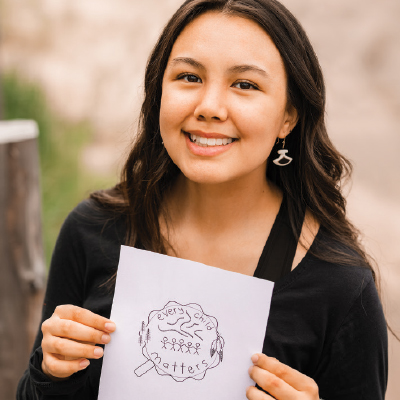
a young Inuk artist from Nunatsiavut and
a member of the Happy Valley-Goose Bay
Corps, N.L., to design the artwork for
Orange Shirt Day
(Photos: Becken Photogpraphy)
“The Salvation Army in Canada and Bermuda is supporting Orange Shirt Day as part of our overall journey of reconciliation,” says Commissioner Floyd Tidd, territorial commander. “We believe the core message of this day, that ‘Every Child Matters,’ and we stand in solidarity with Indigenous Peoples in this initiative.”
Recognizing the Harm
The Indian residential school system—designed to assimilate Indigenous children into mainstream society—was a central part of Canada’s Indigenous policy almost from the beginning. In 1867, when Canada became a country, there were already a number of church-run boarding schools for Indigenous children. In 1876, the Indian Act allowed the federal government to establish such schools.
Canada’s first prime minister, Sir John A. Macdonald, told the House of Commons that “when the school is on the reserve, the child lives with its parents, who are savages … Indian children should be withdrawn as much as possible from the parental influence.” He argued they should be placed in schools “where they will acquire the habits and modes of thought of white men.”
The same year, the federal government established three large residential schools in western Canada, and the school system grew quickly from there. By 1931, there were 80. In total, 139 government-funded, church-run schools operated across the country, with the last one closing in 1996. It’s estimated that more than 150,000 First Nations, Métis and Inuit children, between the ages of four and 16, were compelled to attend residential schools.
These children were taken—often by force—from their families and homes, stripped of their names and belongings, and separated from their siblings. They were forbidden to speak their languages or practise their customs and spiritual traditions. The education and vocational training they received was substandard and often gave way to manual labour. They faced fear, loneliness and harsh discipline. Many were physically, sexually or psychologically abused. Although the exact number is not known, as many as 6,000 died.
The Truth and Reconciliation Commission of Canada has said that, in removing children from their families, communities and culture, the residential school system is best described as “cultural genocide.”
Confronting the Legacy
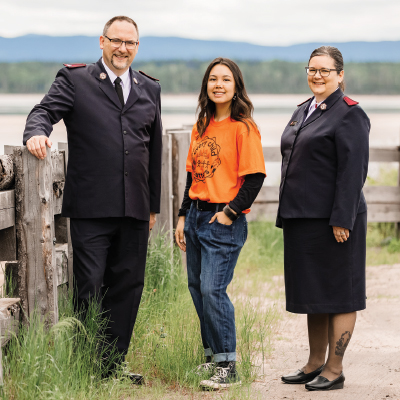
COs, Happy Valley-Goose Bay Corps, N.L.
In 1996, the final report of a Royal Commission on Aboriginal Peoples was released, bringing national attention to the harms of the Indian residential school experience. In the following years, several thousand court cases related to this legacy resulted in the largest class-action lawsuit and settlement in Canadian history. The settlement agreement, which took effect in 2007, included the establishment of a Truth and Reconciliation Commission (TRC).
The TRC’s purpose was to document the history and impact of the Indian residential school system on former students and their families. The commission spent six years travelling across Canada, gathering testimonies from more than 6,000 survivors through national events and community hearings. In 2015, it released a final report. “Now that we know about residential schools and their legacy, what do we do about it?” the report asked, offering 94 Calls to Action.
Action #48 called church and faith groups to adopt and implement the United Nations Declaration on the Rights of Indigenous Peoples as a framework for reconciliation. On March 30, 2016, an ecumenical group, including The Salvation Army, issued a formal response at a press conference on Parliament Hill.
“As Christ has called us to be ministers of reconciliation in this world, we recognize our responsibility in engaging the principles of this declaration,” said Major Shari Russell, territorial Indigenous ministries consultant.
In its statement, the Army committed to developing a comprehensive plan in response to each of the appropriate Calls to Action: “We realize reconciliation is an ongoing process that acknowledges our past with Indigenous Peoples, reframes our current relationships and works toward a future based on dignity and trust.”
Emphasizing communication and consultation with Indigenous people, the plan included a focus on accessibility, building trust, awareness and education, leadership development and addressing the needs of Indigenous women.
Remember and Change
Since then, the Army has held two roundtables to bring together Indigenous Salvationists from across the territory for support and encouragement, as well as several celebrations of Indigenous cultures, with workshops and traditional pow wows.
“As an organization, we seek to respect and honour Indigenous people—their stories, their ceremonies, their ways of knowing,” says Captain Crystal Porter, divisional children and youth secretary, Prairie Division, and associate territorial Indigenous ministries consultant.
“Partnering with the Orange Shirt Society in support of Orange Shirt Day is another tangible way to actively engage in reconciliation. The Salvation Army is acknowledging the past hurt and working to heal and restore that relationship.”
For Captain Porter, this work is deeply personal. It wasn’t until she attended Booth University College in Winnipeg that she began a journey to reclaim and embrace her Mi’kmaw heritage.
“The roundtables that Major Russell organized were key—just being able to connect with other Indigenous people in the Army and to share our journeys,” she says. “For me, the path of healing and reconciliation, being able to reclaim my culture, has happened through these events. Seeing the Army commit to the work of reconciliation, to be willing to learn, to walk gently, has been important.
“In moments like this, as we honour residential school survivors and their families through Orange Shirt Day, my faith and my Indigenous identity come together. Reconciliation is a spiritual process.”
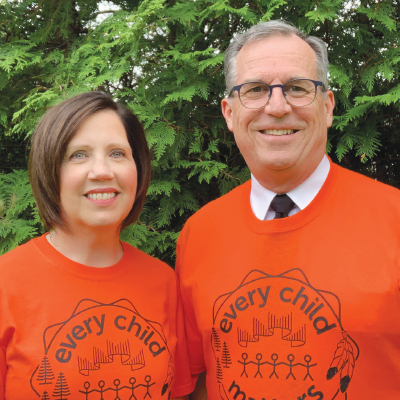
that ‘Every Child Matters,’ and we stand in
solidarity with Indigenous Peoples in this
initiative,” says Commissioner Floyd Tidd,
with Commissioner Tracey Tidd, territorial
president of women’s ministries
Committed to Reconciliation
Orange Shirt Day opens the door to a conversation about the legacy and ongoing impact of Indian residential schools, but also to current injustices.
“The Salvation Army is working with and alongside Indigenous groups and communities to rebuild relationships and respond to the recommendations from the TRC,” says Commissioner Floyd Tidd. “The recent discovery of unmarked graves has reminded us as a country about the historical mistreatment and abuse of Indigenous children, but we acknowledge that this mistreatment is not just a historical reality or a ‘dark chapter.’ “
Indigenous people continue to experience injustice and inequitable treatment. The Salvation Army desires to be part of the solution and not the problem. We are committed to supporting and walking alongside them in communities from coast to coast.”
Visit the corps mission resource page or Canada Bermuda Youth for resources in support of Orange Shirt Day, including sermons, children and youth programming, educational and partnership ideas, and Sunday service ideas.
You Matter
Each survivor carries a unique, valid, heavy, true story in their hearts. I used a drum to represent not only Inuit but many other Indigenous groups. The drum expresses the soul and deep, soothing heartbeat of Indigenous culture.
The northern lights signify the beautiful teachings and knowledge of Indigenous culture, and the people holding hands below represent Indigenous people reconnecting with their identity, language and traditions, and celebrating their strong, beautiful, resilient heritage.
The trees represent the journey of breaking the chains of hurt and brokenness and planting a path of healing together, where change can begin to grow.
The feather symbolizes freedom. It was no easy road for the ones before us to get to this point of freely expressing ourselves and our culture together.
It’s important to keep these cultural practices going because there were many who weren’t allowed to. I realize that each element of this symbol may resonate differently within each person who has been impacted by residential schools and I hope that they sense a feeling of strength from this symbol and know that their feelings, their stories and their voice matters. You matter.
—Trinity Murphy-Dicker
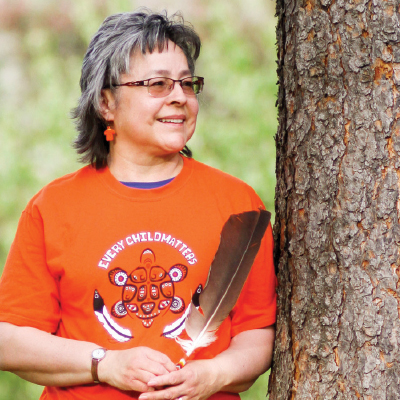
(Shuswap) from the Stswecem’c Xgat’tem First Nation
(Canoe Creek Indian Band), is the executive director
of the Orange Shirt Society. She tours the country
sharing her story and raising awareness about the
impact of the residential school system
(Photo: Danielle Shack)
The Orange Shirt
I went to the Mission for one school year in 1973/1974. I had just turned six years old. I lived with my grandmother on the Dog Creek reserve. We never had very much money, but somehow my granny managed to buy me a new outfit to go to the Mission school. I remember going to Robinson’s store and picking out a shiny orange shirt. It had string laced up in front and was so bright and exciting—just like I felt to be going to school!
When I got to the Mission, they stripped me and took away my clothes, including the orange shirt! I never wore it again. I didn’t understand why they wouldn’t give it back to me—it was mine! The colour orange has always reminded me of that and how my feelings didn’t matter, how no one cared and how I felt like I was worth nothing. All of us little children were crying, and no one cared.
I was 13 years old and in Grade 8 when my son, Jeremy, was born. Because my grandmother and mother both attended residential school for 10 years each, I never knew what a parent was supposed to be like. With the help of my aunt, Agness Jack, I was able to raise my son and have him know me as his mother.
I went to a treatment centre for healing when I was 27 and have been on this healing journey since then. I finally get it, that the feeling of worthlessness and insignificance, ingrained in me from my first day at the Mission, affected the way I lived my life for many years. Even now, when I know nothing could be further from the truth, I still sometimes feel that I don’t matter. Even with all the work I’ve done!
I am honoured to be able to tell my story so that others may benefit and understand, and maybe other survivors will feel comfortable enough to share their stories.
—Phyllis (Jack) Webstad
This story is from:




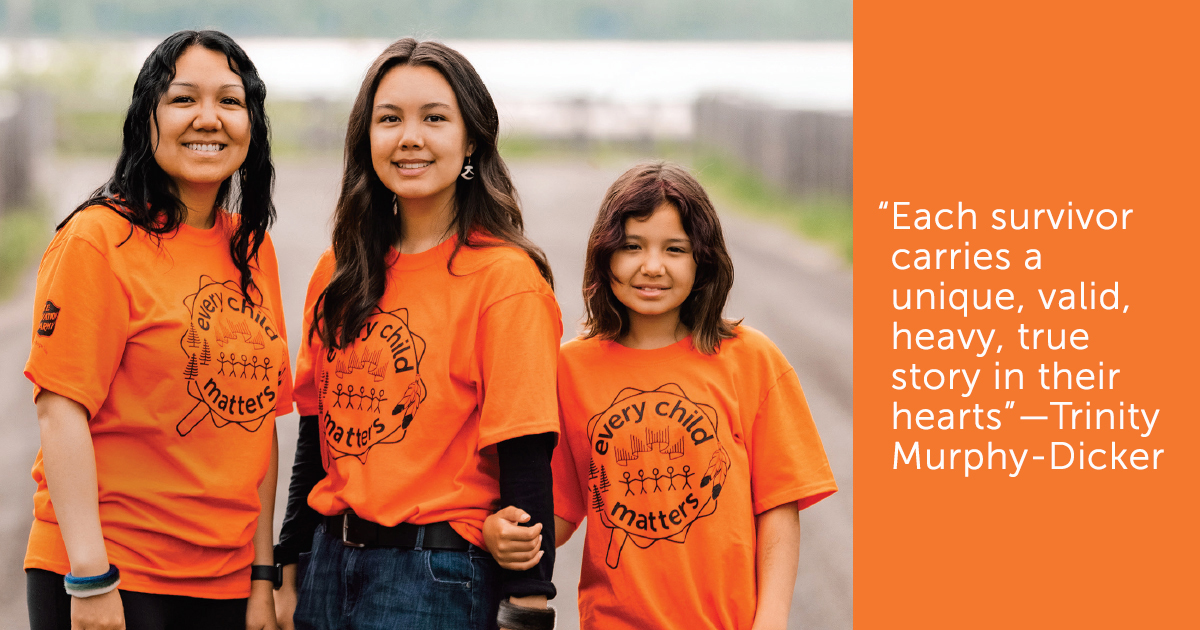
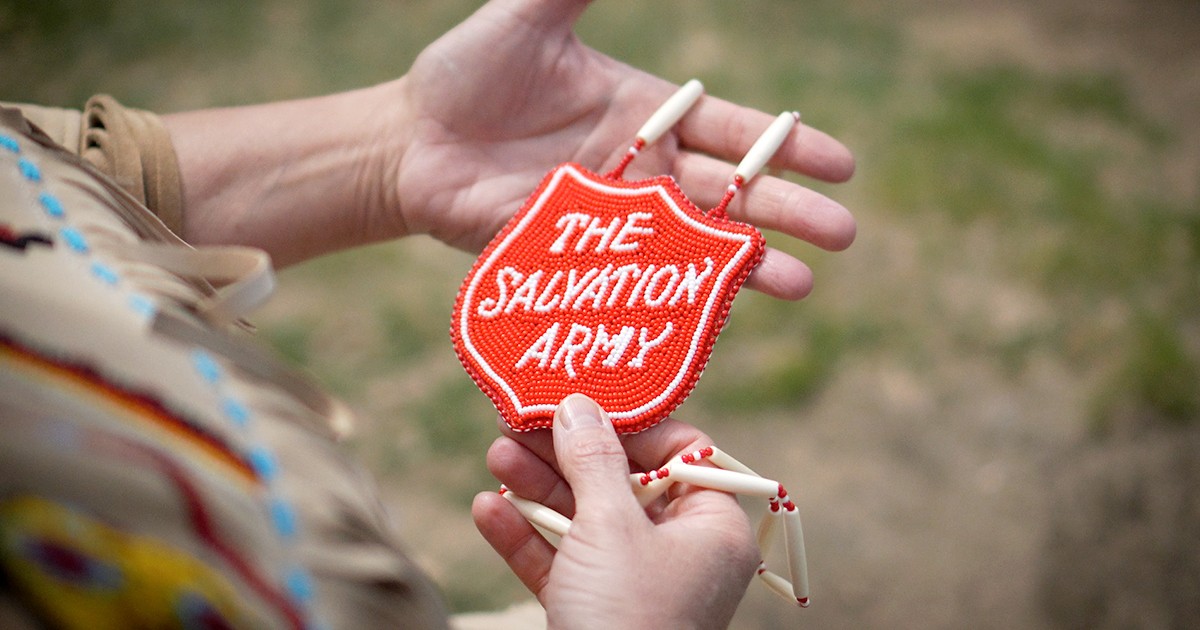
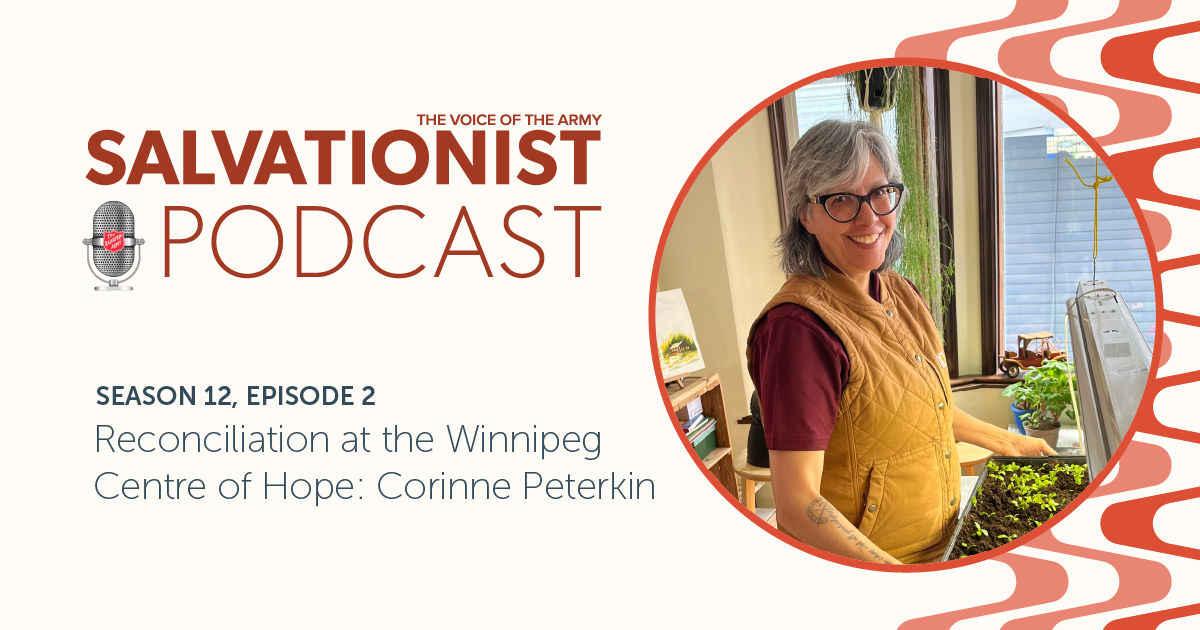
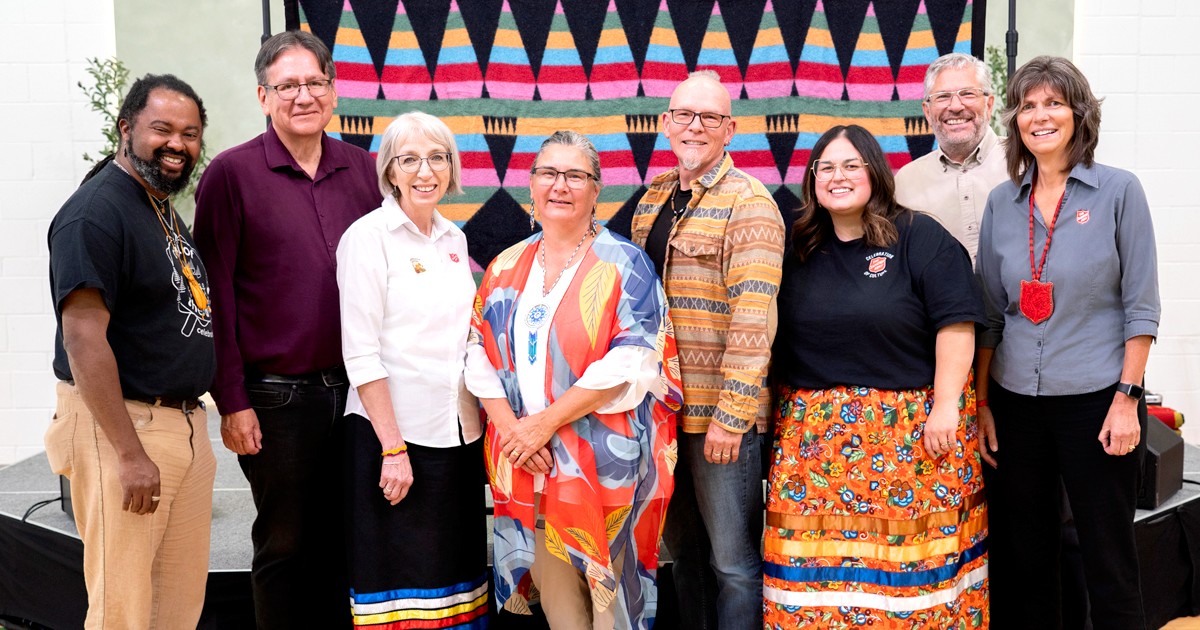


Leave a Comment